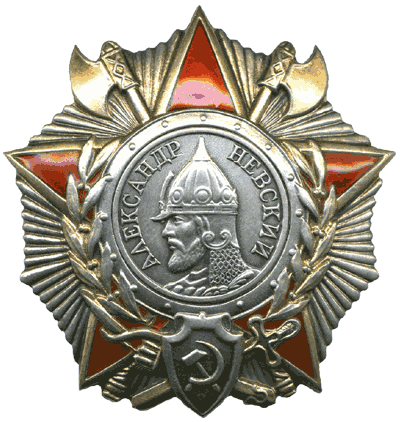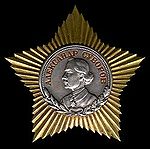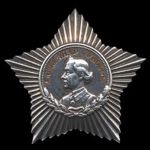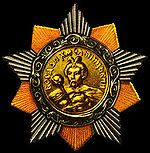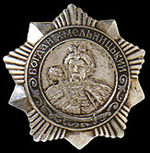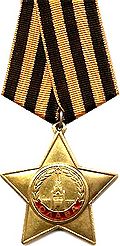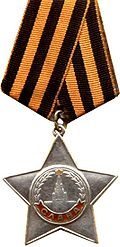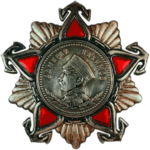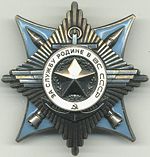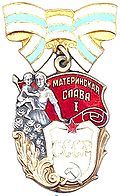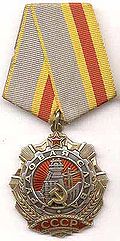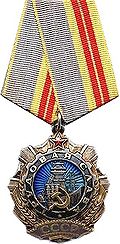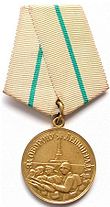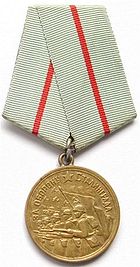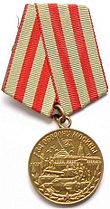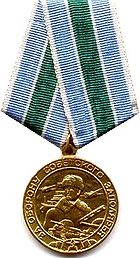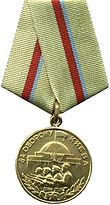Awards and decorations of the Soviet Union are decorations from the Former
. Some of the awards, decorations and orders were discontinued after the
, while others still issued by the Russian Federation as of 2010. Many of the awards were simply reworked in the Russian Federation, such as the transition of
. A wide range of Soviet awards and decorations cover the extensive and diverse period of history from 1917 to 1991.
Badge And Ribbon |
Name (EnglishEnglish is a West Germanic language that arose in the Anglo-Saxon kingdoms of England and spread into what was to become south-east Scotland under the influence of the Anglian medieval kingdom of Northumbria...
/RussianRussian is a Slavic language used primarily in Russia, Belarus, Uzbekistan, Kazakhstan, Tajikistan and Kyrgyzstan. It is an unofficial but widely spoken language in Ukraine, Moldova, Latvia, Turkmenistan and Estonia and, to a lesser extent, the other countries that were once constituent republics...
/TranslitTranslit is a method of encoding Cyrillic letters with Latin ones. The term is derived from transliteration, the system of replacing letters of one alphabet with letters of another....
) |
Creation Date |
Description |
Number Awarded |
|
Order of VictoryThe Order of Victory was the highest military decoration in the Soviet Union, and one of the rarest orders in the world. The order was awarded only to Generals and Marshals for successfully conducting combat operations involving one or more army groups and resulting in a "successful operation...
Орден «Победа»
Orden «Pobeda» |
8 November 1943 |
The Order of VictoryThe Order of Victory was the highest military decoration in the Soviet Union, and one of the rarest orders in the world. The order was awarded only to Generals and Marshals for successfully conducting combat operations involving one or more army groups and resulting in a "successful operation...
was the highest military decoration in the Soviet Armed Forces and one of the rarest in the world due to the small number of recipients. It was established on 8 November 1943 and awarded only to Generals and Marshals for "successful operation within the framework of one or several fronts resulting in a radical change of the situation in favour of the Red Army". Made of platinumPlatinum is a chemical element with the chemical symbol Pt and an atomic number of 78. Its name is derived from the Spanish term platina del Pinto, which is literally translated into "little silver of the Pinto River." It is a dense, malleable, ductile, precious, gray-white transition metal...
, rubies and 150 diamondIn mineralogy, diamond is an allotrope of carbon, where the carbon atoms are arranged in a variation of the face-centered cubic crystal structure called a diamond lattice. Diamond is less stable than graphite, but the conversion rate from diamond to graphite is negligible at ambient conditions...
s, the intrinsic value of the order is considerable. The badge depicts the Spasskaya Tower of the Moscow KremlinA kremlin , same root as in kremen is a major fortified central complex found in historic Russian cities. This word is often used to refer to the best-known one, the Moscow Kremlin, or metonymically to the government that is based there...
, with Lenin's MausoleumLenin's Mausoleum also known as Lenin's Tomb, situated in Red Square in the center of Moscow, is the mausoleum that serves as the current resting place of Vladimir Lenin. His embalmed body has been on public display there since shortly after his death in 1924...
in front. |
20 |
 |
Order of the Red BannerThe Soviet government of Russia established the Order of the Red Banner , a military decoration, on September 16, 1918 during the Russian Civil War...
Орден Крaсного Знамени
Orden Krasnogo Znameni |
1 August 1924 |
The Order of the Red Banner recognised military deeds. Before the establishment of the Order of LeninThe Order of Lenin , named after the leader of the Russian October Revolution, was the highest decoration bestowed by the Soviet Union...
, the Order of the Red Banner functioned as the highest (and practically the only) military order of the USSR. Practically all well-known Soviet commanders became Cavaliers of the Order of the Red Banner. Also awarded to NKVD personnel. |
581,300 |
 |
Order of the Red StarEstablished on 6 April 1930, the Order of the Red Star was an order of the Soviet Union, given to Red Army and Soviet Navy personnel for "exceptional service in the cause of the defense of the Soviet Union in both war and peace". It was established by Resolution of the Presidium of the CEC of the...
Орден Красной Звезды
Orden Krasnoj Zvezdy |
6 April 1930 |
The Order of the Red Star was given to Red Army and Navy personnel for exceptional service in the cause of the defence of the Soviet Union in both war and peace. Also awarded for 15 years of service prior to the creation of the long service awards. |
3,876,740 |
 |
Order of the Patriotic WarThe Order of the Patriotic War is a Soviet military decoration that was awarded to all soldiers in the Soviet armed forces, security troops, and to partisans for heroic deeds during the German-Soviet War, known by the former-Soviet Union as the Great Patriotic War.- History :The Order was...
1st class
Орден Отечественной войны
первой степени
Orden Otechestvennoj vojny
pervoj stepeni |
20 May 1942 |
The Order of the Patriotic WarThe Order of the Patriotic War is a Soviet military decoration that was awarded to all soldiers in the Soviet armed forces, security troops, and to partisans for heroic deeds during the German-Soviet War, known by the former-Soviet Union as the Great Patriotic War.- History :The Order was...
was awarded to all soldiers in the Soviet armed forces, security troops, and to partisans for heroic deeds during the Great Patriotic War. In 1985 during the celebration of the 40th anniversary of the Great Patriotic War, it was decided that all surviving veterans of the war would be awarded either 2nd or 1st class of the Order. |
2,627,899 |
 |
Order of the Patriotic WarThe Order of the Patriotic War is a Soviet military decoration that was awarded to all soldiers in the Soviet armed forces, security troops, and to partisans for heroic deeds during the German-Soviet War, known by the former-Soviet Union as the Great Patriotic War.- History :The Order was...
2nd class
Орден Отечественной Войны
второй степени
Orden Otechestvennoj vojny
vtoroj stepeni |
20 May 1942 |
The Order of the Patriotic WarThe Order of the Patriotic War is a Soviet military decoration that was awarded to all soldiers in the Soviet armed forces, security troops, and to partisans for heroic deeds during the German-Soviet War, known by the former-Soviet Union as the Great Patriotic War.- History :The Order was...
was awarded to all soldiers in the Soviet armed forces, security troops, and to partisans for heroic deeds during the Great Patriotic War. In 1985 during the celebration of the 40th anniversary of the Great Patriotic War, it was decided that all surviving veterans of the war would be awarded either 2nd or 1st class of the Order. |
6,716,384 |
|
Order of Alexander NevskyThe Order of Alexander Nevsky is an order of merit bestowed by the Russian Federation. It is named in honour ofAlexander Nevsky's struggle with the Teutonic Knights....
Орден Александра Невского
Orden Aleksandra Nevskogo |
29 July 1942 |
To officers of the army for personal courage and resolute leadership. |
50,585 |
 |
Order of SuvorovThe Order of Suvorov is a Soviet award, named after Aleksandr Suvorov , that was established on July 29, 1942 by a decision of the Presidium of Supreme Soviet of the USSR. This decoration was created to award senior army personnel for exceptional leadership in combat operations...
1st class
Орден Суворова
первой степени
Orden Suvorova
pervoj stepeni |
29 July 1942 |
The 1st class order is awarded to army commanders for exceptional direction of combat operations. |
393 |
 |
Order of SuvorovThe Order of Suvorov is a Soviet award, named after Aleksandr Suvorov , that was established on July 29, 1942 by a decision of the Presidium of Supreme Soviet of the USSR. This decoration was created to award senior army personnel for exceptional leadership in combat operations...
2nd class
Орден Суворова
второй степени
Orden Suvorova
vtoroj stepeni |
29 July 1942 |
The 2nd class order is awarded to corps, divisions and brigade commanders for a decisive victory over a numerically superior enemy. |
2,862 |
 |
Order of SuvorovThe Order of Suvorov is a Soviet award, named after Aleksandr Suvorov , that was established on July 29, 1942 by a decision of the Presidium of Supreme Soviet of the USSR. This decoration was created to award senior army personnel for exceptional leadership in combat operations...
3rd class
Орден Суворова
третьей степени
Orden Suvorova
tret'ej stepeni |
4 February 1943 |
The 3rd class order is awarded to regimental commanders, their chiefs of staff, and battalion and company commanders for outstanding leadership leading to a battle victory. |
4,012 |
 |
Order Of KutuzovThe Order of Kutuzov is a Soviet and Russian military award, named after famous Russian Field Marshal Mikhail Illarionovich Kutuzov ....
1st class
Орден Кутузова
первой степени
Orden Kutuzova
pervoj stepeni |
29 July 1942 |
The Order Of Kutuzov (1st class) was created to award commanders of fronts and armies for skilful evasions of enemy attacks and successful counter attacks. |
669 |
 |
Order Of KutuzovThe Order of Kutuzov is a Soviet and Russian military award, named after famous Russian Field Marshal Mikhail Illarionovich Kutuzov ....
2nd class
Орден Кутузова
второй степени
Orden Kutuzova
vtoroj stepeni |
29 July 1942 |
The Order Of Kutuzov (2nd class) was created to award commanders of corps, divisions and brigades for skilful evasions of enemy attacks and successful counter-attacks. |
3,325 |
 |
Order Of KutuzovThe Order of Kutuzov is a Soviet and Russian military award, named after famous Russian Field Marshal Mikhail Illarionovich Kutuzov ....
3rd class
Орден Кутузова
третьей степени
Orden Kutuzova
tеret'ej stepeni |
8 February 1943 |
The Order Of Kutuzov (3rd class) was created to award commanders, their chiefs of staff, battalion and company commanders for skilful evasions of enemy attacks and successful counter-attacks. |
3,328 |
 |
Order of Bogdan KhmelnitskyThe Order of Bohdan Khmelnitsky was a Soviet award named after Bohdan Khmelnytsky, Hetman of the Ukrainian Cossack Hetmanate The award was first established on October 10, 1943, by the Presidium of Supreme Soviet of the USSR during World War II....
1st class
Орден Богдана Хмельницкого
первой степени
Orden Bogdana Hmel'nitskogo
pervoj stepeni |
10 October 1943 |
The 1st class order was awarded to front or army commanders for successful direction of combat operations that led to the liberation of a region or town inflicting heavy casualties on the enemy. |
323 |
 |
Order of Bogdan KhmelnitskyThe Order of Bohdan Khmelnitsky was a Soviet award named after Bohdan Khmelnytsky, Hetman of the Ukrainian Cossack Hetmanate The award was first established on October 10, 1943, by the Presidium of Supreme Soviet of the USSR during World War II....
2nd class
Орден Богдана Хмельницкого
второй степени
Orden Bogdana Hmel'nitskogo
vtoroj stepeni |
10 October 1943 |
The 2nd class order was awarded to corps, divisions, brigade or battalion commanders for a breach of defensive enemy line or a raid in the enemy rear. |
2,389 |
 |
Order Of Bogdan KhmelnitskyThe Order of Bohdan Khmelnitsky was a Soviet award named after Bohdan Khmelnytsky, Hetman of the Ukrainian Cossack Hetmanate The award was first established on October 10, 1943, by the Presidium of Supreme Soviet of the USSR during World War II....
3rd class
Орден Богдана Хмельницкого
третьей степени
Orden Bogdana Hmel'nitskogo
tret'ej stepeni |
10 October 1943 |
The 3rd class medal was awarded to officers, partisan commanders, sergeants, corporals and privates of the Red Army and partisan units for outstanding bravery and resourcefulness leading to a battle victory. |
5,738 |
 |
Order of GloryEstablished on 8 November 1943, the Order of Glory was an Order of the Soviet Union. It was awarded to non-commissioned officers and rank-and-file of the armed forces, as well as junior lieutenants of the air force, for bravery in the face of the enemy.The Order of Glory, which was modelled...
1st class
Орден «Слава»
первой степени
Orden «Slava»
pervoj stepeni |
8 November 1943 |
The Order of Glory, modelled closely upon the Tsarist Cross of St. Georgethumb|Original Cross of St. George.Ist and 2nd class were in gold.The Cross of St. George ', or simply the George's Cross, was, until 1913, officially known as the Sign of Distinction of the Military Order of St. George....
, was awarded to non-commissioned officers and soldiers of the armed forces, as well as junior lieutenantA lieutenant is a junior commissioned officer in many nations' armed forces. Typically, the rank of lieutenant in naval usage, while still a junior officer rank, is senior to the army rank...
s of the air forceAn air force, also known in some countries as an air army, is in the broadest sense, the national military organization that primarily conducts aerial warfare. More specifically, it is the branch of a nation's armed services that is responsible for aerial warfare as distinct from an army, navy or...
, for bravery in the face of the enemy. A person initially received the third degree, and would subsequently be promoted to higher degrees for further acts of bravery. |
2,620 |
 |
Order of GloryEstablished on 8 November 1943, the Order of Glory was an Order of the Soviet Union. It was awarded to non-commissioned officers and rank-and-file of the armed forces, as well as junior lieutenants of the air force, for bravery in the face of the enemy.The Order of Glory, which was modelled...
2nd class
Орден «Слава»
второй степени
Orden «Slava»
vtoroj stepeni |
8 November 1943 |
The Order of Glory, modelled closely upon the Tsarist Cross of St. Georgethumb|Original Cross of St. George.Ist and 2nd class were in gold.The Cross of St. George ', or simply the George's Cross, was, until 1913, officially known as the Sign of Distinction of the Military Order of St. George....
, was awarded to non-commissioned officers and soldiers of the armed forces, as well as junior lieutenantA lieutenant is a junior commissioned officer in many nations' armed forces. Typically, the rank of lieutenant in naval usage, while still a junior officer rank, is senior to the army rank...
s of the air forceAn air force, also known in some countries as an air army, is in the broadest sense, the national military organization that primarily conducts aerial warfare. More specifically, it is the branch of a nation's armed services that is responsible for aerial warfare as distinct from an army, navy or...
, for bravery in the face of the enemy. A person initially received the third degree, and would subsequently be promoted to higher degrees for further acts of bravery. |
46,473 |
 |
Order of GloryEstablished on 8 November 1943, the Order of Glory was an Order of the Soviet Union. It was awarded to non-commissioned officers and rank-and-file of the armed forces, as well as junior lieutenants of the air force, for bravery in the face of the enemy.The Order of Glory, which was modelled...
3rd class
Орден «Слава»
третьей степени
Orden «Slava»
tret'ej stepeni |
8 November 1943 |
The Order of Glory, modelled closely upon the Tsarist Cross of St. Georgethumb|Original Cross of St. George.Ist and 2nd class were in gold.The Cross of St. George ', or simply the George's Cross, was, until 1913, officially known as the Sign of Distinction of the Military Order of St. George....
, was awarded to non-commissioned officers and soldiers of the armed forces, as well as junior lieutenantA lieutenant is a junior commissioned officer in many nations' armed forces. Typically, the rank of lieutenant in naval usage, while still a junior officer rank, is senior to the army rank...
s of the air forceAn air force, also known in some countries as an air army, is in the broadest sense, the national military organization that primarily conducts aerial warfare. More specifically, it is the branch of a nation's armed services that is responsible for aerial warfare as distinct from an army, navy or...
, for bravery in the face of the enemy. A person initially received the third degree, and would subsequently be promoted to higher degrees for further acts of bravery. |
997,815 |
 |
Order of UshakovThe Order of Ushakov was one of the highest naval awards of the Soviet Union among the Order of Nakhimov and it active is up to this day. Its name commemorates the Admiral Fyodor Ushakov, who never lost a battle and was proclaimed patron saint of the Russian Navy.The order was instituted during...
1st class
Орден Ушакова
первой степени
Orden Ushakova
pervoj stepeni |
3 March 1944 |
Awarded to naval officers for outstanding achievements in planning and conducting naval operations and for victories in combat resulting from such operations. |
47 |
 |
Order of UshakovThe Order of Ushakov was one of the highest naval awards of the Soviet Union among the Order of Nakhimov and it active is up to this day. Its name commemorates the Admiral Fyodor Ushakov, who never lost a battle and was proclaimed patron saint of the Russian Navy.The order was instituted during...
2nd class
Орден Ушакова
второй степени
Orden Ushakova
vtoroj stepeni |
3 March 1944 |
Awarded to naval officers for excellent direction and successful planning of a sea battle against a numerically superior enemy that results in the annihilation of many forces. |
198 |
 |
Order of NakhimovOrder of Nakhimov is one of the highest naval awards in former USSR and nominally in Russian Federation, along with the order of Ushakov. Established on March 3, 1944, it has two classes, both of them feature an anchor-shaped star...
1st class
Орден Нахимова
первой степени
Orden Nakhimova
pervoj stepeni |
3 March 1944 |
Awarded to naval officers for outstanding planning and execution of operations. |
80 |
 |
Order of NakhimovOrder of Nakhimov is one of the highest naval awards in former USSR and nominally in Russian Federation, along with the order of Ushakov. Established on March 3, 1944, it has two classes, both of them feature an anchor-shaped star...
2nd class
Орден Нахимова
второй степени
Orden Nakhimova
vtoroj stepeni |
3 March 1944 |
Awarded to naval officers for outstanding planning and execution of operations. |
467 |
 |
Order "For Service to the Homeland in the Armed Forces of the USSR"The Order for Service to the Homeland in the Armed Forces of the USSR also known as Order of Service to Motherland was a USSR military order created on 28 October 1974, making it the first military order created after the end of World War II.According to its statute, the order was awarded for...
1st class
Орден «За службу Родине в Вооружённых Силах СССР»
первой степени
Orden «Za sluzhbu Rodine v Vooruzhennykh Silakh SSSR»
pervoj stepeni |
28 October 1974 |
This order was awarded for exemplary service in the armed forces, both during a war and during peacetime. A recipient was first awarded a 3rd class order, then if further deeds were made, the second and the first class. Like the civilian Order of Labour GloryThe Order of Labour Glory was a Soviet civilian award created on 18 January 1974 by the decision of the Praesidium of Supreme Soviet of the USSR. Closely modeled on the Order of Glory, it was meant to be its civilian counterpart, awarded for exceptional labour achievements...
upon which it is modeled, it gave a certain number of material benefits to their owners. |
13 |
 |
Order "For Service to the Homeland in the Armed Forces"The Order for Service to the Homeland in the Armed Forces of the USSR also known as Order of Service to Motherland was a USSR military order created on 28 October 1974, making it the first military order created after the end of World War II.According to its statute, the order was awarded for...
2nd class
Орден «За службу Родине в Вооружённых Силах СССР»
второй степени
Orden «Za sluzhbu Rodine v Vooruzhennykh Silakh SSSR»
vtoroj stepeni |
28 October 1974 |
This order was awarded for exemplary service in the armed forces, both during a war and during peacetime. A recipient was first awarded a 3rd class order, then if further deeds were made, the second and the first class. Like the civilian Order Of Labour GloryThe Order of Labour Glory was a Soviet civilian award created on 18 January 1974 by the decision of the Praesidium of Supreme Soviet of the USSR. Closely modeled on the Order of Glory, it was meant to be its civilian counterpart, awarded for exceptional labour achievements...
upon which it is modeled, it gave a certain number of material benefits to their owners. |
589 |
 |
Order "For Service To The Homeland In The Armed Forces"The Order for Service to the Homeland in the Armed Forces of the USSR also known as Order of Service to Motherland was a USSR military order created on 28 October 1974, making it the first military order created after the end of World War II.According to its statute, the order was awarded for...
3rd class
Орден «За службу Родине в Вооружённых Силах СССР»
третьей степени
Orden «Za sluzhbu Rodine v Vooruzhennykh Silakh SSSR»
tret'ej stepeni |
28 October 1974 |
This order was awarded for exemplary service in the armed forces, both during a war and during peacetime. A recipient was first awarded a 3rd class order, then if further deeds were made, the second and the first class. Like the civilian Order Of Labour GloryThe Order of Labour Glory was a Soviet civilian award created on 18 January 1974 by the decision of the Praesidium of Supreme Soviet of the USSR. Closely modeled on the Order of Glory, it was meant to be its civilian counterpart, awarded for exceptional labour achievements...
upon which it is modeled, it gave a certain number of material benefits to their owners. |
69,576 |
Badge And Ribbon |
Name (EnglishEnglish is a West Germanic language that arose in the Anglo-Saxon kingdoms of England and spread into what was to become south-east Scotland under the influence of the Anglian medieval kingdom of Northumbria...
/RussianRussian is a Slavic language used primarily in Russia, Belarus, Uzbekistan, Kazakhstan, Tajikistan and Kyrgyzstan. It is an unofficial but widely spoken language in Ukraine, Moldova, Latvia, Turkmenistan and Estonia and, to a lesser extent, the other countries that were once constituent republics...
/TranslitTranslit is a method of encoding Cyrillic letters with Latin ones. The term is derived from transliteration, the system of replacing letters of one alphabet with letters of another....
) |
Creation Date |
Description |
Number Awarded |
 |
Order of the Red Banner of LabourThe Order of the Red Banner of Labour was an order of the Soviet Union for accomplishments in labour and civil service. It is the labour counterpart of the military Order of the Red Banner. A few institutions and factories, being the pride of Soviet Union, also received the order.-History:The Red...
Орден Трудового Красного Знамени
Orden Trudovogo Krasnogo Znameni |
7 September 1928 |
This order was established as the civilian counterpart of the military Order of the Red BannerThe Soviet government of Russia established the Order of the Red Banner , a military decoration, on September 16, 1918 during the Russian Civil War...
and was awarded for exceptional working achievements. |
1,259,942 |
 |
Order of the Badge of HonourThe Order of the Badge of Honour was a civilian award of the Soviet Union.It was instituted on 25 November 1935 and conferred on citizens of the USSR for outstanding achievements in production, scientific research and social, cultural and other forms of social activity, for promotion of economic,...
Орден «Знак Почета»
Orden «Znak Pocheta» |
25 November 1935 |
This order conferred on citizens of the USSR for "outstanding achievements in production, scientific research and social, cultural and other forms of social activity". It was replaced on 28 December 1988 by the Order Of Honour, with an almost identical appearance. |
1,574,368 |
|
Order of Maternal GloryThe Order of Maternal Glory was a Soviet civilian award created on 8 July 1944 by Joseph Stalin and established with a decision of the Praesidium of Supreme Soviet of the USSR....
1st class
Орден «Материнская слава»
I степени
Orden «Materinskaja slava»
I stepeni |
8 July 1944 |
This decoration was awarded to all mothers bearing and raising 9 children. It was awarded upon the first birthday of the last child, provided that eight other children (natural or adopted) remained alive. Children who had perished under heroic, military or other respectful circumstances were also counted. |
881,070 |
|
Order of Maternal GloryThe Order of Maternal Glory was a Soviet civilian award created on 8 July 1944 by Joseph Stalin and established with a decision of the Praesidium of Supreme Soviet of the USSR....
2nd class
Орден «Материнская слава»
II степени
Orden «Materinskaja slava»
II stepeni |
8 July 1944 |
This decoration was awarded to all mothers bearing and raising 8 children. It was awarded upon the first birthday of the last child, provided that seven other children (natural or adopted) remained alive. Children who had perished under heroic, military or other respectful circumstances were also counted. |
1,697,223 |
|
Order of Maternal GloryThe Order of Maternal Glory was a Soviet civilian award created on 8 July 1944 by Joseph Stalin and established with a decision of the Praesidium of Supreme Soviet of the USSR....
3rd class
Орден «Материнская слава»
III степени
Orden «Materinskaja slava»
III stepeni |
8 July 1944 |
This decoration was awarded to all mothers bearing and raising 7 children. It was awarded upon the first birthday of the last child, provided that six other children (natural or adopted) remained alive. Children who had perished under heroic, military or other respectful circumstances were also counted. |
3,083,328 |
 |
Order of the October RevolutionThe Order of the October Revolution was instituted on October 31, 1967, in time for the 50th anniversary of the October Revolution. It was awarded to individuals or groups for services furthering communism or the state, or in enhancing the defenses of the Soviet Union, military and civil...
Орден «Октябрьской Революции»
Orden Oktjabr'skoj Revolyutsii |
31 October 1967 |
Created for the 50th anniversary of the October RevolutionThe October Revolution , also known as the Great October Socialist Revolution , Red October, the October Uprising or the Bolshevik Revolution, was a political revolution and a part of the Russian Revolution of 1917...
, this order was awarded to individuals or groups for services furthering communismCommunism is a social, political and economic ideology that aims at the establishment of a classless, moneyless, revolutionary and stateless socialist society structured upon common ownership of the means of production...
or the state or in enhancing the defences of the Soviet UnionThe Soviet Union , officially the Union of Soviet Socialist Republics , was a constitutionally socialist state that existed in Eurasia between 1922 and 1991....
. |
106,462 |
 |
Order of Labour GloryThe Order of Labour Glory was a Soviet civilian award created on 18 January 1974 by the decision of the Praesidium of Supreme Soviet of the USSR. Closely modeled on the Order of Glory, it was meant to be its civilian counterpart, awarded for exceptional labour achievements...
1st class
Орден Трудовой Славы
первой степени
Orden Trudovoj Slavy
pervoj stepeni |
18 January 1974 |
Closely modelled on the Order of GloryEstablished on 8 November 1943, the Order of Glory was an Order of the Soviet Union. It was awarded to non-commissioned officers and rank-and-file of the armed forces, as well as junior lieutenants of the air force, for bravery in the face of the enemy.The Order of Glory, which was modelled...
, this order was meant to be its civilianA civilian under international humanitarian law is a person who is not a member of his or her country's armed forces or other militia. Civilians are distinct from combatants. They are afforded a degree of legal protection from the effects of war and military occupation...
counterpart, awarded for exceptional labourManual labour , manual or manual work is physical work done by people, most especially in contrast to that done by machines, and also to that done by working animals...
achievements. In the same way as the Order of GloryEstablished on 8 November 1943, the Order of Glory was an Order of the Soviet Union. It was awarded to non-commissioned officers and rank-and-file of the armed forces, as well as junior lieutenants of the air force, for bravery in the face of the enemy.The Order of Glory, which was modelled...
, it was divided in three classes (the highest being the 1st class), with a person initially received the third degree, and subsequently promoted to higher degrees for further achievements. It also gave a certain number of material benefits to their owners, such as an increased pensionIn general, a pension is an arrangement to provide people with an income when they are no longer earning a regular income from employment. Pensions should not be confused with severance pay; the former is paid in regular installments, while the latter is paid in one lump sum.The terms retirement...
raises and free public transport. |
952 |
 |
Order of Labour GloryThe Order of Labour Glory was a Soviet civilian award created on 18 January 1974 by the decision of the Praesidium of Supreme Soviet of the USSR. Closely modeled on the Order of Glory, it was meant to be its civilian counterpart, awarded for exceptional labour achievements...
2nd class
Орден Трудовой Славы
второй степени
Orden Trudovoj Slavy
vtoroj stepeni |
18 January 1974 |
Closely modelled on the Order of GloryEstablished on 8 November 1943, the Order of Glory was an Order of the Soviet Union. It was awarded to non-commissioned officers and rank-and-file of the armed forces, as well as junior lieutenants of the air force, for bravery in the face of the enemy.The Order of Glory, which was modelled...
, this order was meant to be its civilianA civilian under international humanitarian law is a person who is not a member of his or her country's armed forces or other militia. Civilians are distinct from combatants. They are afforded a degree of legal protection from the effects of war and military occupation...
counterpart, awarded for exceptional labour achievements. In the same way as the Order of GloryEstablished on 8 November 1943, the Order of Glory was an Order of the Soviet Union. It was awarded to non-commissioned officers and rank-and-file of the armed forces, as well as junior lieutenants of the air force, for bravery in the face of the enemy.The Order of Glory, which was modelled...
, it was divided in three classes (the highest being the 1st class), with a person initially received the third degree, and subsequently promoted to higher degrees for further achievements. It also gave a certain number of material benefits to their owners, such as an increased pensionIn general, a pension is an arrangement to provide people with an income when they are no longer earning a regular income from employment. Pensions should not be confused with severance pay; the former is paid in regular installments, while the latter is paid in one lump sum.The terms retirement...
raises and free public transportTransport or transportation is the movement of people, cattle, animals and goods from one location to another. Modes of transport include air, rail, road, water, cable, pipeline, and space. The field can be divided into infrastructure, vehicles, and operations...
. |
45,197 |
 |
Order of Labour GloryThe Order of Labour Glory was a Soviet civilian award created on 18 January 1974 by the decision of the Praesidium of Supreme Soviet of the USSR. Closely modeled on the Order of Glory, it was meant to be its civilian counterpart, awarded for exceptional labour achievements...
3rd class
Орден Трудовой Славы
третьей степени
Orden Trudovoj Slavy
tret'ej stepeni |
18 January 1974 |
Closely modelled on the Order of GloryEstablished on 8 November 1943, the Order of Glory was an Order of the Soviet Union. It was awarded to non-commissioned officers and rank-and-file of the armed forces, as well as junior lieutenants of the air force, for bravery in the face of the enemy.The Order of Glory, which was modelled...
, this order was meant to be its civilianA civilian under international humanitarian law is a person who is not a member of his or her country's armed forces or other militia. Civilians are distinct from combatants. They are afforded a degree of legal protection from the effects of war and military occupation...
counterpart, awarded for exceptional labour achievements. In the same way as the Order of GloryEstablished on 8 November 1943, the Order of Glory was an Order of the Soviet Union. It was awarded to non-commissioned officers and rank-and-file of the armed forces, as well as junior lieutenants of the air force, for bravery in the face of the enemy.The Order of Glory, which was modelled...
, it was divided in three classes (the highest being the 1st class), with a person initially received the third degree, and subsequently promoted to higher degrees for further achievements. It also gave a certain number of material benefits to their owners, such as an increased pensionIn general, a pension is an arrangement to provide people with an income when they are no longer earning a regular income from employment. Pensions should not be confused with severance pay; the former is paid in regular installments, while the latter is paid in one lump sum.The terms retirement...
raises and free public transportTransport or transportation is the movement of people, cattle, animals and goods from one location to another. Modes of transport include air, rail, road, water, cable, pipeline, and space. The field can be divided into infrastructure, vehicles, and operations...
. |
637,816 |
 |
Order "For Personal Courage"The Order for Personal Courage was established by Presidium of the Supreme Soviet of the USSR on December 28, 1988.This decoration could be awarded to any USSR citizen showing outstanding courage and bravery during life-saving, keeping of public order and safeguard of State property, as well as for...
Орден «За личное мужество»
Orden «Za lichnoe muzhestvo» |
28 December 1988 |
This decoration could be awarded to any USSR citizen showing outstanding courage and bravery during life-saving, keeping of public order and safeguard of StateA sovereign state, or simply, state, is a state with a defined territory on which it exercises internal and external sovereignty, a permanent population, a government, and the capacity to enter into relations with other sovereign states. It is also normally understood to be a state which is neither...
propertyProperty is any physical or intangible entity that is owned by a person or jointly by a group of people or a legal entity like a corporation...
, as well as for fighting crimeCrime is the breach of rules or laws for which some governing authority can ultimately prescribe a conviction...
, environmental catastrophes and other exceptional events. |
529 |
Badge And Ribbon |
Name (EnglishEnglish is a West Germanic language that arose in the Anglo-Saxon kingdoms of England and spread into what was to become south-east Scotland under the influence of the Anglian medieval kingdom of Northumbria...
/RussianRussian is a Slavic language used primarily in Russia, Belarus, Uzbekistan, Kazakhstan, Tajikistan and Kyrgyzstan. It is an unofficial but widely spoken language in Ukraine, Moldova, Latvia, Turkmenistan and Estonia and, to a lesser extent, the other countries that were once constituent republics...
/TranslitTranslit is a method of encoding Cyrillic letters with Latin ones. The term is derived from transliteration, the system of replacing letters of one alphabet with letters of another....
) |
Creation Date |
Description |
Number Awarded |
|
Medal "For CourageThe Medal "For Courage" was the highest military medal that could be awarded to a soldier of the Soviet Union for bravery on the field of battle...
"
Медаль «За отвагу»
Medal «Za otvagu» |
17 October 1938 |
The Medal for Courage was the highest military medalA medal, or medallion, is generally a circular object that has been sculpted, molded, cast, struck, stamped, or some way rendered with an insignia, portrait, or other artistic rendering. A medal may be awarded to a person or organization as a form of recognition for athletic, military, scientific,...
that could be awarded to a soldierA soldier is a member of the land component of national armed forces; whereas a soldier hired for service in a foreign army would be termed a mercenary...
for bravery on the field of battle. The tank pictured is a T-35The T-35 was a Soviet multi-turreted heavy tank of the interwar period and early Second World War that saw limited production and service with the Red Army. It was the only five-turreted heavy tank in the world to reach production but proved to be slow and mechanically unreliable...
and the planes bore strong resemblance to Polikarpovs. It was awarded for "acts of bravery during a battle, during the defence of the state borderBorders define geographic boundaries of political entities or legal jurisdictions, such as governments, sovereign states, federated states and other subnational entities. Some borders—such as a state's internal administrative borders, or inter-state borders within the Schengen Area—are open and...
s or during military duties associated with risk to life." |
4,569,893 |
|
Medal "For Combat MeritsThe USSR Medal for Combat Service was a Soviet military medal awarded for "combat action resulting in a military success", "courageous defense of the state borders", or "successful military and political training and preparation".It was created on October 17, 1938 by the decision of the Presidium...
"
Медаль «За боевые заслуги»
Medal «Za boevye zaslugi» |
17 October 1938 |
This military medal awarded for "combat action resulting in a military success", "courageous defence of the state borders", or "successful military and political training and preparation". Also awarded for 10 years of service prior to the creation of the long service awards. |
5,210,078 |
 |
Medal "Partisan of the Patriotic War"
1st class
Медаль «Партизану Отечественной войны»
I степени
Medal «Partizanu Otechestvennoj vojny»
I stepeni |
22 February 1943 |
Awarded to partisans and partisan movement organisers for courage and valour against occupying troops during the Great Patriotic War. |
56,883 |
 |
Medal "Partisan of the Patriotic War"
2nd class
Медаль «Партизану Отечественной войны»
II степени
Medal «Partizanu Otechestvennoj vojny«
II stepeni |
22 February 1943 |
Awarded to partisans and partisan movement organisers for courage and valour against occupying troops during the Great Patriotic War. |
70,992 |
|
Ushakov MedalThe Ushakov Medal was a USSR military medal, created on March 3, 1944 by the decision of the Supreme Soviet of the USSR. Its name commemorates the admiral Fyodor Ushakov, who never lost a battle and was proclaimed patron saint of the Russian Navy...
Медаль Ушакова
Medal Ushakova |
3 March 1944 |
This medal was awarded to fleet officers and soldiers, both during war and peacetime, for courage and bravery during military operations, state borders patrol, and military duties with life risk. Note that the "peacetime" part results from a modification of the status in 1980 (before that, the medal used to be awarded only during wars). |
15,641 |
|
Nakhimov Medal
Медаль Нахимова
Medal Nakhimova |
3 March 1944 |
Awarded to those in Naval Service for valour and gallantry during sea battles and to for those not in naval service who with efficient and resourceful actions at the risk of their lives, contributed to the successful outcome of combat missions involving Soviet Naval Forces. |
14,020 |
 |
Medal "For Distinction in Guarding the State Border of the USSR"The Distinguished Serive in Guarding the State Border was a USSR military medal, created on July 13, 1950. It was awarded to all border troops, servicemen and civilians for outstanding military deeds related to state frontier security. A gold medal was awarded, on the same basis, exclusively to...
Медаль «За отличие в охране государственной границы СССР»
Medal «Za otlichie v okhrane gosudarstvennoj granitsy SSSR» |
13 July 1950 |
Awarded to K.G.B. Border TroopsSoviet Border Troops, were the militarized border guard of the Soviet Union, subordinated to its subsequently reorganized state security agency: first to Cheka/OGPU, then to NKVD/MGB and, finally, to KGB...
personnel for military or other actions displaying excellence in guarding the Soviet borders. |
c. 67,520 |
 |
Medal "For Distinguished Service in Preservation of Public Order"
Медаль «За отличную службу по охране общественного порядка»
Medal «Za otlichnuyu sluzhbu po ohrane obschestvennogo porjadka» |
1 November 1950 |
Awarded to members of the Ministry of Internal Affairs (MVD) and its Internal TroopsThe Internal Troops, full name Internal Troops of the Ministry for Internal Affairs ; alternatively translated as "Interior " is a paramilitary gendarmerie-like force in the now-defunct Soviet Union and its successor countries, particularly, in Russia, Ukraine, Georgia and Azerbaijan...
for aiding in preserving public order. |
c. 47,000 |
|
Medal "For Distinction in Military Service"
1st class
Медаль «За отличие в воинской службе»
I степени
Medal «Za otlichie v voinskoj sluzhbe»
I stepeni |
28 October 1974 |
Awarded to all military personnel for Distinguished Service. |
c. 20,000 |
|
Medal "For Distinction in Military Service"
2nd class
Медаль «За Отличие В Воинской Службе»
II степени
Medal «Za otlichie v voinskoj sluzhbe»
II stepeni |
28 October 1974 |
Awarded to all military personnel for Distinguished Service. |
c. 120,000 |
|
Medal "For Strengthening Combat Co-Operation"
Медаль «За укрепление боевого содружества»
Medal «Za ukreplenie boevogo sodruzhestva» |
25 May 1979 |
Awarded to service personnel who strengthened the military co-operation of the forces of the Warsaw PactThe Warsaw Treaty Organization of Friendship, Cooperation, and Mutual Assistance , or more commonly referred to as the Warsaw Pact, was a mutual defense treaty subscribed to by eight communist states in Eastern Europe...
nations. |
c. 20,000 |
 |
Medal "For Impeccable Service"
First class
Медаль «За безупречную службу»
первой степени
Medal «Za bezuprechnuju sluzhbu»
pervoj stepeni |
25 January 1958 |
Awarded for 20 years good service. |
|
 |
Medal "For Impeccable Service"
Second class
Медаль «За безупречную службу»
второй степени
Medal «Za bezuprechnuju sluzhbu»
vtoroj stepeni |
25 January 1958 |
Awarded for 15 years good service. |
|
 |
Medal "For Impeccable Service"
Third Class
Медаль «За безупречную службу»
третьей степени
Medal «Za bezuprechnuju sluzhbu»
tret'ej stepeni |
25 January 1958 |
Awarded for 10 years of good service. |
|
|
Medal "Veteran of Armed Forces of the USSR"
Медаль «Ветеран Вооружённых Сил СССР»
Medal «Veteran Vooruzhennyh Sil SSSR» |
25 May 1976 |
For 25 Years military service. |
c. 880,000 |
Badge And Ribbon |
Name (EnglishEnglish is a West Germanic language that arose in the Anglo-Saxon kingdoms of England and spread into what was to become south-east Scotland under the influence of the Anglian medieval kingdom of Northumbria...
/RussianRussian is a Slavic language used primarily in Russia, Belarus, Uzbekistan, Kazakhstan, Tajikistan and Kyrgyzstan. It is an unofficial but widely spoken language in Ukraine, Moldova, Latvia, Turkmenistan and Estonia and, to a lesser extent, the other countries that were once constituent republics...
/TranslitTranslit is a method of encoding Cyrillic letters with Latin ones. The term is derived from transliteration, the system of replacing letters of one alphabet with letters of another....
) |
Creation Date |
Description |
Number Awarded |
 |
Medal "For the Defence of LeningradThe Siege of Leningrad, also known as the Leningrad Blockade was a prolonged military operation resulting from the failure of the German Army Group North to capture Leningrad, now known as Saint Petersburg, in the Eastern Front theatre of World War II. It started on 8 September 1941, when the last...
"
Медаль «За оборону Ленинграда»
Medal «Za oboronu Leningrada» |
22 December 1942 |
Awarded to all Soviet military and civilians who participated in the defence of LeningradLeningrad is the former name of Saint Petersburg, Russia.Leningrad may also refer to:- Places :* Leningrad Oblast, a federal subject of Russia, around Saint Petersburg* Leningrad, Tajikistan, capital of Muminobod district in Khatlon Province...
between 8 September 1941 and 27 January 1944. |
c. 1,496,000 |
 |
Medal "For the Defence of OdessaThe Siege of Odessa was part of the Eastern Front area of operations in 1941, it was primarily conducted by Romanian forces and elements of the German Army's 11th Army...
"
Медаль «За оборону Одессы»
Medal «Za oboronu Odessy» |
22 December 1942 |
Awarded to all Soviet military and civilians who participated in the defence of OdessaOdessa or Odesa is the administrative center of the Odessa Oblast located in southern Ukraine. The city is a major seaport located on the northwest shore of the Black Sea and the fourth largest city in Ukraine with a population of 1,029,000 .The predecessor of Odessa, a small Tatar settlement,...
between 10 August and 16 October 1941. |
c. 38,000 |
 |
Medal "For the Defence of SevastopolThe Siege of Sevastopol took place on the Eastern Front of the Second World War. The campaign was fought by the Axis powers of Germany, Romania and Italy against the Soviet Union for control of Sevastopol, a port in Crimea on the Black Sea. On 22 June 1941 the Axis invaded the Soviet Union under...
"
Медаль «За оборону Севастополя»
Medal «Za oboronu Sevastopolja» |
22 December 1942 |
Awarded to all Soviet military and civilians who participated in the defence of SevastopolSevastopol is a city on rights of administrative division of Ukraine, located on the Black Sea coast of the Crimea peninsula. It has a population of 342,451 . Sevastopol is the second largest port in Ukraine, after the Port of Odessa....
between 5 November 1941 and 4 July 1942. |
52,540 |
 |
Medal "For the Defence of StalingradThe Battle of Stalingrad was a major battle of World War II in which Nazi Germany and its allies fought the Soviet Union for control of the city of Stalingrad in southwestern Russia. The battle took place between 23 August 1942 and 2 February 1943...
"
Медаль «За оборону Сталинграда»
Medal «Za oboronu Stalingrada» |
22 December 1942 |
Awarded to all Soviet military and civilians who participated in the defence of Stalingrad between 12 July and 19 November 1942. |
759,560 |
 |
Medal "For the Defence of MoscowThe Battle of Moscow is the name given by Soviet historians to two periods of strategically significant fighting on a sector of the Eastern Front during World War II. It took place between October 1941 and January 1942. The Soviet defensive effort frustrated Hitler's attack on Moscow, capital of...
"
Медаль «За оборону Москвы»
Medal «Za oboronu Moskvy» |
1 May 1944 |
Awarded to all Soviet military and civilians who participated in the defence of MoscowMoscow is the capital, the most populous city, and the most populous federal subject of Russia. The city is a major political, economic, cultural, scientific, religious, financial, educational, and transportation centre of Russia and the continent...
between 19 October 1941 and 25 January 1942. |
1,028,600 |
 |
Medal "For the Defence of the Caucasus"
Медаль «За оборону Кавказа»
Medal «Za oboronu Kavkaza» |
1 May 1944 |
Awarded to all Soviet military and civilians who participated in the defence of the Caucasus region between July 1942 and 9 October 1943. |
c. 870,000 |
|
Medal "For the Defence of the Soviet TransarcticThe Continuation War was the second of two wars fought between Finland and the Soviet Union during World War II.At the time of the war, the Finnish side used the name to make clear its perceived relationship to the preceding Winter War...
"
Медаль «За оборону Советского Заполярья»
Medal «Za oboronu Sovestkogo Zapoliarja» |
5 December 1944 |
Awarded to all Soviet military and civilians who participated in the defence of the Soviet Trans-Arctic regions between 25 June 1941 and 19 September 1944. |
353,240 |
 |
Medal "For the Defence of KievThe Battle of Kiev was the German name for the operation that resulted in a very large encirclement of Soviet troops in the vicinity of Kiev during World War II. It is considered the largest encirclement of troops in history. The operation ran from 23 August – 26 September 1941 as part of Operation...
"
Медаль «За оборону Киева»
Medal «Za oboronu Kieva» |
21 June 1961 |
Awarded to all Soviet military and civilians who participated in the defence of KievKiev or Kyiv is the capital and the largest city of Ukraine, located in the north central part of the country on the Dnieper River. The population as of the 2001 census was 2,611,300. However, higher numbers have been cited in the press....
between 7 July and 26 September 1941. |
107,540 |
Badge And Ribbon |
Name (EnglishEnglish is a West Germanic language that arose in the Anglo-Saxon kingdoms of England and spread into what was to become south-east Scotland under the influence of the Anglian medieval kingdom of Northumbria...
/RussianRussian is a Slavic language used primarily in Russia, Belarus, Uzbekistan, Kazakhstan, Tajikistan and Kyrgyzstan. It is an unofficial but widely spoken language in Ukraine, Moldova, Latvia, Turkmenistan and Estonia and, to a lesser extent, the other countries that were once constituent republics...
/TranslitTranslit is a method of encoding Cyrillic letters with Latin ones. The term is derived from transliteration, the system of replacing letters of one alphabet with letters of another....
) |
Creation Date |
Description |
Number Awarded |
 |
Medal "For the Capture of BerlinThe Battle of Berlin, designated the Berlin Strategic Offensive Operation by the Soviet Union, was the final major offensive of the European Theatre of World War II....
"
Медаль «За взятие Берлина»
Medal «Za vzjatie Berlina» |
9 June 1945 |
Awarded to Soviet service personnel who took part in the capture of Berlin from 22 April and 2 May 1945 |
c. 1,100,000 |
 |
Medal "For the Capture of BudapestThe Siege of Budapest centered on the Hungarian capital city of Budapest. It was fought towards the end of World War II in Europe, during the Soviet Budapest Offensive. The siege started when Budapest, defended by Hungarian and German troops, was first encircled on 29 December 1944 by the Red Army...
"
Медаль «За взятие Будапешта»
Medal «Za vzjatie Budapeshta» |
9 June 1945 |
Awarded to Soviet service personnel who took part in the capture of Budapest between 20 December 1944 and 15 February 1945. |
362,050 |
 |
Medal "For the Capture of KönigsbergThe Battle of Königsberg , was one of the last operations of the East Prussian Offensive during World War II. In four days of violent urban warfare, Soviet forces of the 1st Baltic Front and the 3rd Belorussian Front captured the city of Königsberg...
"
Медаль «За взятие Кенигсберга»
Medal «Za vzjatie Kenigsberga» |
9 June 1945 |
Awarded to Soviet service personnel who took part in the capture of Königsberg between 23 January and 10 April 1945. |
c. 760,000 |
 |
Medal "For the Liberation of PragueThe Prague Offensive was the last major Soviet operation of World War II in Europe. The offensive, and the battle for Prague, was fought on the Eastern Front from 6 May to 11 May 1945. This battle for the city is particularly noteworthy in that it ended after the Third Reich capitulated on 8 May...
"
Медаль «За освобождение Праги»
Medal «Za osvobozhdenie Pragi» |
9 June 1945 |
Awarded to Soviet service personnel who took part in the liberation of Prague between the 3 and 9 May 1945. |
400,070 |
 |
Medal "For the Capture of ViennaThe Vienna Offensive was launched by the Soviet 3rd Ukrainian Front in order to capture Vienna, Austria. The offensive lasted from 2–13 April 1945...
"
Медаль «За взятие Вены»
Medal «Za vzjatie Veny» |
9 June 1945 |
Awarded to Soviet service personnel who took part in the capture of Vienna between 16 March and 13 April 1945 |
277,380 |
|
Medal "For the Liberation of WarsawThe Vistula–Oder Offensive was a successful Red Army operation on the Eastern Front in the European Theatre of World War II; it took place between 12 January and 2 February 1945...
"
Медаль «За освобождение Варшавы»
Medal «Za osvobozhdenie Warshavy» |
9 June 1945 |
Awarded to Soviet service personnel who took part in the occupation of Warsaw between the 14 and 17 January 1945. |
701,700 |
 |
Medal "For the Liberation of BelgradeThe Belgrade Offensive or the Belgrade Strategic Offensive Operation was an offensive military operation in which Belgrade was conquered from the German Wehrmacht by the joint efforts of the Yugoslav Partisans and the Soviet Red Army...
"
Медаль «За освобождение Белграда»
Medal «Za osvobozhdenie Belgrada» |
9 June 1945 |
Awarded to Soviet service personnel who took part in the liberation of Belgrade between 29 September and 22 October 1944. |
c. 70,000 |
 |
Medal "For Victory over Germany in the Great Patriotic War 1941-1945The Medal For The Victory Over Germany In The Great Patriotic War 1941–1945 was one of the most widespread military decorations in the Soviet Union. 14,933,000 people were awarded this medal...
"
Медаль «За Победу над Германией в Великой Отечественной войне 1941-1945 гг.»
Medal «Za Pobedu nad Germaniej v Velikoj Otechestvennoj vojne 1941-1945 gg.» |
9 May 1945 |
Awarded to Soviet service personnel who were on active service during The Great Patriotic War (Military service of 3 months or civil service of 6 months). Also awarded to some allied forces such as the post 9 September 1944 Bulgarian Armed Forces. |
14,933,000 |
 |
Medal "For Victory over JapanThe medal For the Victory Over Japan was a Soviet military decoration, awarded to all the soldiers, officers and partisans who directly participated in the live combat actions against Japan during the Second World War...
"
Медаль «За победу над Японией»
Medal «Za pobedu nad Japoniej» |
30 September 1945 |
Awarded to Soviet service personnel of the 1st and 2nd Far East Trans-Baikal Fronts, Pacific Fleet and Amur River Flotilla who were active between 8 August and 23 August 1945. |
c. 1,831,000 |
Badge And Ribbon |
Name (EnglishEnglish is a West Germanic language that arose in the Anglo-Saxon kingdoms of England and spread into what was to become south-east Scotland under the influence of the Anglian medieval kingdom of Northumbria...
/RussianRussian is a Slavic language used primarily in Russia, Belarus, Uzbekistan, Kazakhstan, Tajikistan and Kyrgyzstan. It is an unofficial but widely spoken language in Ukraine, Moldova, Latvia, Turkmenistan and Estonia and, to a lesser extent, the other countries that were once constituent republics...
/TranslitTranslit is a method of encoding Cyrillic letters with Latin ones. The term is derived from transliteration, the system of replacing letters of one alphabet with letters of another....
) |
Creation Date |
Description |
Number Awarded |
|
Medal "For Labour Valour"
Медаль «За трудовую доблесть»
Medal «Za trudovuyu doblest» |
27 December 1938 |
Awarded to labourers who heroically dedicated themselves towards the building of a socialist society or have demonstrated a complete understanding of machinery/equipment to provide a high level of efficiency or for significant contributions in culture/science/manufacturing. |
1,825,100 |
|
Medal "For Labour Distinction"
Медаль «За трудовое отличие»
Medal «Za trudovoe otlichie» |
27 December 1938 |
Awarded to labourers who distinguished themselves with high production rates or for development of culture/science/manufacturing. |
2,146,400 |
|
Medal "For Valiant Labour during the Great Patriotic War 1941-1945"
Медаль «За доблестный труд в Великой Отечественной войне 1941—1945 гг.»
Medal «Za doblestnyj trud v Velikoj Otechestvennoj vojne 1941-1945 gg.» |
6 June 1945 |
Awarded to all Soviet industrial workers for a term of one year or longer of labour during The Great Patriotic War. (6 months for disabled military veterans/professional school graduates/the retired who returned to work to aid.) |
16,096,750 |
|
Medal "For Distinguished Service in Maintaining Public Order"
Медаль «За отличную службу по охране общественного порядка»
Medal «Za otlichnuyu sluzhbu po ohrane obschestvennogo porjadka» |
1 November 1950 |
Awarded to all service personnel of the militsiyaMilitsiya or militia is used as an official name of the civilian police in several former communist states, despite its original military connotation...
for courage shown during the liquidation of criminal groups and arrest of criminal or for excellence in organising and coordinating militia in combating crime or for selfless acts during the prevention of hooliganism/alcoholism/theft. |
c. 27,000 |
|
Medal "For the Rescue of the Drowning"
Медаль «За спасение утопающих»
Medal «Za spasenie utopayushchikh» |
16 February 1957 |
Awarded to any person (of any nationality) for courage, bravery and selflessness whilst rescuing a person/people from water or for outstanding vigilance and resourcefulness preventing drowning or for excellence in organising of rescue operations in Soviet waters or of Soviet citizens. |
c. 27,000 |
|
Medal "For Courage during Fire"
Медаль «За отвагу на пожаре»
Medal «Za otvagu na pozhare» |
30 October 1957 |
Awarded all Soviet citizens for courage and bravery in extinguishing fires or saving lives/state or private property from fire or for preventing explosions and fires. |
c. 32,000 |
|
Medal "Veteran of LabourThe Veteran of Labour Medal was a medal of the USSR. It was established by a Decree of the Presidium of the Supreme Soviet of the USSR on 18 January 1974...
"
Медаль «Ветеран труда»
Medal «Veteran truda» |
18 January 1974 |
Awarded to all state workers at Retirement. |
c. 39,197,100 |
Badge And Ribbon |
Name (EnglishEnglish is a West Germanic language that arose in the Anglo-Saxon kingdoms of England and spread into what was to become south-east Scotland under the influence of the Anglian medieval kingdom of Northumbria...
/RussianRussian is a Slavic language used primarily in Russia, Belarus, Uzbekistan, Kazakhstan, Tajikistan and Kyrgyzstan. It is an unofficial but widely spoken language in Ukraine, Moldova, Latvia, Turkmenistan and Estonia and, to a lesser extent, the other countries that were once constituent republics...
/TranslitTranslit is a method of encoding Cyrillic letters with Latin ones. The term is derived from transliteration, the system of replacing letters of one alphabet with letters of another....
) |
Creation Date |
Description |
Number Awarded |
 |
Medal "For Restoration of Coal Mines of the Donbass"
Медаль «За восстановление угольных шахт Донбасса»
Medal «Za vosstanovlenie ugl'nyh shaht Donbassa» |
10 September 1947 |
Awarded to the Soviet supervisors and machine operators of the Donbass (most of the work was done by prisoners of war). 129 large coal pits, 889 smaller coal pits and 300 mine heads were rebuilt or constructed. 700 lifting machines were also made operative. |
46,350 |
 |
Medal "For Restoration of the Enterprises of Black Metallurgy in the South"
Медаль «За восстановление предприятий чёрной металлургии юга»
Medal «Za vosstanovlenie predprijatij chernoj metallurgii yuga» |
18 May 1948 |
Awarded to Soviet workers of outstanding performance in restoring the Black Metallurgic Enterprises of the Soviet Union which were destroyed during the Great Patriotic War. 13 blast furnaces, 49 open furnaces, 29 finishing mills and 68 coke-oven batteries were restored to effective or outstanding production rates. |
68,710 |
 |
Medal "For Development of the Virgin Lands"
Медаль «За освоение целинных земель»
Medal «Za osvoenie tselinnyh zemel» |
20 October 1956 |
Awarded to all Soviet workers who helped cultivate 36,000,000 hectares of previously uncultivated lands in Kazakhstan, Siberia, the Urals, the Volga area and the northern Caucasus for two solid years from 1954-1956. |
c. 1,300,000 |
 |
Medal "For Construction of the Baikal-Amur Railway"
Медаль «За строительство Байкало-Амурской магистрали»
Medal «Za stroitel'stvo Bajkalo-Amurskoj magistrali» |
8 October 1976 |
Awarded to workers on the Baikul-Amur Railway (BAM) for 2 years outstanding service between 1974 and 1984. |
c. 69,000 |
 |
Medal "For Transforming the "Non-Black Earth" of the Russian Soviet Federative Socialist Republic"
Медаль «За преобразование Нечерноземья РСФСР»
Medal «Za preobrazovanie Тechernozem'ja RSFSR» |
30 September 1977 |
Awarded for 3 years outstanding service in developing Soviet agriculture. |
c. 55,000 |
 |
Medal "For Tapping of the Subsoil and Expansion of the petrochemical complex of Western Siberia"
Медаль «За освоение недр и развитие нефтегазового комплекса Западной Сибири»
Medal «Za osvoenie nedr i razvitie neftegazovogo kompleksa Zapadnoj Sibiri» |
28 July 1978 |
Awarded for 3 years outstanding service in the Petrochemical Complex Of Western Siberia. |
c. 38,000 |
Badge And Ribbon |
Name (EnglishEnglish is a West Germanic language that arose in the Anglo-Saxon kingdoms of England and spread into what was to become south-east Scotland under the influence of the Anglian medieval kingdom of Northumbria...
/RussianRussian is a Slavic language used primarily in Russia, Belarus, Uzbekistan, Kazakhstan, Tajikistan and Kyrgyzstan. It is an unofficial but widely spoken language in Ukraine, Moldova, Latvia, Turkmenistan and Estonia and, to a lesser extent, the other countries that were once constituent republics...
/TranslitTranslit is a method of encoding Cyrillic letters with Latin ones. The term is derived from transliteration, the system of replacing letters of one alphabet with letters of another....
) |
Creation Date |
Description |
Number Awarded |
|
People's Doctor of the USSRPeople's Doctor of the USSR was an honorary title granted to citizens of the Soviet Union; it was established in 25 October 1977 by Leonid Brezhnev and its creation was officialised on the n°44/1977 issue of Suprem Soviet's official journal....
Медаль Народный врач СССР |
25 October 1977 |
This decoration was awarded for worthwhile contributions to public healthPublic health is "the science and art of preventing disease, prolonging life and promoting health through the organized efforts and informed choices of society, organizations, public and private, communities and individuals" . It is concerned with threats to health based on population health...
improvement. |
|
|
People's Architect of the USSRPeople's Architect of the USSR , also sometimes translated as National Architect of the USSR, was an honorary title granted to citizens of the Soviet Union; it was established on August 12, 1967 by Leonid Brezhnev....
Медаль Народный архитектор СССР |
12 August 1967 |
This decoration was awarded for stunning results either in urban planningUrban planning incorporates areas such as economics, design, ecology, sociology, geography, law, political science, and statistics to guide and ensure the orderly development of settlements and communities....
or in the design of important buildings. |
|
|
People's Teacher of the USSRPeople's Teacher of the USSR was an honorary title granted to citizens of the Soviet Union; it was established in 30 December 1977.Following the Dissolution of the Soviet Union the title was modified in National Teacher of the Russian Federation....
Медаль Народный учитель СССР |
30 December 1977 |
This decoration was awarded for worthwhile contributions to the national education system and, mainly, in teaching communismCommunism is a social, political and economic ideology that aims at the establishment of a classless, moneyless, revolutionary and stateless socialist society structured upon common ownership of the means of production...
to children and young people. |
|
|
People's Artist of the USSRPeople's Artist of the USSR, also sometimes translated as National Artist of the USSR, was an honorary title granted to citizens of the Soviet Union.- Nomenclature and significance :...
(Performing arts)
Медаль Народный артист СССР |
13 January 1937 |
This decoration was awarded for exceptional achievements in performing artsThe performing arts are those forms art which differ from the plastic arts insofar as the former uses the artist's own body, face, and presence as a medium, and the latter uses materials such as clay, metal or paint which can be molded or transformed to create some physical art object...
. |
|
|
People's Painter of the USSR
Медаль Народный художник СССР |
16 July 1943 |
This decoration was awarded for exceptional achievements in visual arts as paintingPainting is the practice of applying paint, pigment, color or other medium to a surface . The application of the medium is commonly applied to the base with a brush but other objects can be used. In art, the term painting describes both the act and the result of the action. However, painting is...
, sculptureSculpture is three-dimensional artwork created by shaping or combining hard materials—typically stone such as marble—or metal, glass, or wood. Softer materials can also be used, such as clay, textiles, plastics, polymers and softer metals...
, drawingDrawing is a form of visual art that makes use of any number of drawing instruments to mark a two-dimensional medium. Common instruments include graphite pencils, pen and ink, inked brushes, wax color pencils, crayons, charcoal, chalk, pastels, markers, styluses, and various metals .An artist who...
and photographyPhotography is the art, science and practice of creating durable images by recording light or other electromagnetic radiation, either electronically by means of an image sensor or chemically by means of a light-sensitive material such as photographic film...
. |
|
Badge And Ribbon |
Name (EnglishEnglish is a West Germanic language that arose in the Anglo-Saxon kingdoms of England and spread into what was to become south-east Scotland under the influence of the Anglian medieval kingdom of Northumbria...
/RussianRussian is a Slavic language used primarily in Russia, Belarus, Uzbekistan, Kazakhstan, Tajikistan and Kyrgyzstan. It is an unofficial but widely spoken language in Ukraine, Moldova, Latvia, Turkmenistan and Estonia and, to a lesser extent, the other countries that were once constituent republics...
/TranslitTranslit is a method of encoding Cyrillic letters with Latin ones. The term is derived from transliteration, the system of replacing letters of one alphabet with letters of another....
) |
Creation Date |
Description |
Number Awarded |
 |
Jubilee Medal "20 Years of the Worker's and Peasants' Red Army"
Юбилейная медаль «XX лет Рабоче-Крестьянской Красной Армии»
Yubilejnaja medal «XX let Raboche-Krest'janskoj Krasnoj Armii» |
24 January 1938 |
Awarded to Commanders of the Soviet Army and Navy for 20 years of service and also all who were decorated with the Order of the Red BannerThe Soviet government of Russia established the Order of the Red Banner , a military decoration, on September 16, 1918 during the Russian Civil War...
during the Civil War. (To be returned upon death.) |
37,504 |
 |
Jubilee Medal "30 Years of the Soviet Army and Navy"
Юбилейная медаль «30 лет Советской Армии и Флота»
Yubilejnaja medal «30 let Sovetskoj Armii i Flota» |
18 February 1948 |
Awarded to everyone serving in the military of the Soviet Union 23 February 1948 |
3,710,920 |
 |
Jubilee Medal "40 Years of the Armed Forces of the USSR"
Юбилейная медаль «40 лет Вооружённых Сил СССР»
Yubilejnaja medal «40 let Vooruzhennyh Sil SSSR» |
18 December 1957 |
Awarded to everyone serving in the military of the Soviet Union 23 February 1958 |
820,080 |
 |
Jubilee medal "50 Years of the Armed Forces of the USSR"
Юбилейная медаль «50 лет Вооружённых Сил СССР»
Yubilejnaja medal «50 let Vooruzhennyh Sil SSSR» |
26 December 1967 |
Awarded to
all marshals, generals, officers, cadets, and volunteer enlisted men serving in the military of the Soviet Union and in Soviet state security organs.
All servicemen placed into the reserve or retired after twenty or more years in uniform
All those awarded the title of Hero of the Soviet Union or all three classes of the Order of Glory
All combat veterans, including Civil War and World War II partisans
all those awarded an order or medal for individual service, bravery or achievement regardless of length of service.
23 February 1968 |
9,527,270 |
 |
Jubilee medal "60 Years of the Armed Forces of the USSR"
Юбилейная медаль «60 лет Вооружённых Сил СССР»
Yubilejnaja medal «60 let Vooruzhennyh Sil SSSR» |
28 January 1978 |
Awarded to
all marshals, generals, officers, and volunteer enlisted men serving in the military of the Soviet Union and in Soviet state security organs.
All servicemen placed into the reserve or retired after twenty or more years in uniform
All those awarded the title of Hero of the Soviet Union or all three classes of the Order of Glory
All combat veterans, including Civil War and World War II partisans
all those awarded an order or medal for individual service, bravery or achievement regardless of length of service.
23 February 1978 |
10,723,340 |
 |
Jubilee medal "70 Years of the Armed Forces of the USSR"
Юбилейная медаль «70 лет Вооружённых Сил СССР»
Yubilejnaja medal «70 let Vooruzhennyh Sil SSSR» |
28 January 1988 |
Awarded to
all marshals, generals, officers, cadets, and volunteer enlisted men serving in the military of the Soviet Union and in Soviet state security organs.
All servicemen placed into the reserve or retired after twenty or more years in uniform
All those awarded the title of Hero of the Soviet Union or all three classes of the Order of Glory
All combat veterans, including Civil War and World War II partisans
all those awarded an order or medal for individual service, bravery or achievement regardless of length of service.
23 February 1988 |
9,842,160 |
Badge And Ribbon |
Name (EnglishEnglish is a West Germanic language that arose in the Anglo-Saxon kingdoms of England and spread into what was to become south-east Scotland under the influence of the Anglian medieval kingdom of Northumbria...
/RussianRussian is a Slavic language used primarily in Russia, Belarus, Uzbekistan, Kazakhstan, Tajikistan and Kyrgyzstan. It is an unofficial but widely spoken language in Ukraine, Moldova, Latvia, Turkmenistan and Estonia and, to a lesser extent, the other countries that were once constituent republics...
/TranslitTranslit is a method of encoding Cyrillic letters with Latin ones. The term is derived from transliteration, the system of replacing letters of one alphabet with letters of another....
) |
Creation Date |
Description |
Number Awarded |
 |
Medal "In Memory of the 800th Anniversary of MoscowThe 800th Anniversary of Moscow Medal was a medal in Russia. It was established by a decree of the Supreme Soviet of the USSR on 20 September 1947 in commemoration of the 800th anniversary of the first Russian reference to Moscow, dating to 1147 when Yuri Dolgorukiy called upon the prince of the...
Медаль «В память 800-летия Москвы»
Medal «V pamjat 800-letija Moskvy» |
20 September 1947 |
Awarded to all citizens who participated in the restoration and reconstruction of MoscowMoscow is the capital, the most populous city, and the most populous federal subject of Russia. The city is a major political, economic, cultural, scientific, religious, financial, educational, and transportation centre of Russia and the continent...
. With Citizenship of Moscow of five years or more. Also awarded to all surviving holders of the Medal for the Defence of Moscow. |
c. 1,730,000 |
 |
Medal "In Memory of the 250th Anniversary of Leningrad"The 250th Anniversary of Leningrad Medal was a medal of the Soviet Union, established by the Decree of the Presidium of the Supreme Soviet of the USSR on 16 May 1957 to commemorate the 250th anniversary of the city of Leningrad...
Медаль «В память 250-летия Ленинграда»
Medal «V pamjat 250-letija Leningrada» |
16 May 1957 |
Awarded to all citizens who participated in the restoration and reconstruction of LeningradLeningrad is the former name of Saint Petersburg, Russia.Leningrad may also refer to:- Places :* Leningrad Oblast, a federal subject of Russia, around Saint Petersburg* Leningrad, Tajikistan, capital of Muminobod district in Khatlon Province...
. With Citizenship of Leningrad of five years or more. Also awarded to all surviving holders of the Medal for the Defence of Leningrad. |
c. 1,440,000 |
 |
Jubilee Medal "50 Years of Soviet Militia"The 50 Years of the Soviet Militia Medal was a medal of the Soviet Union, established by a decree of the Praesidium of the Supreme Soviet on 20 November, 1967, to commemorate the 50th anniversary of the Soviet Militia....
Юбилейная медаль «50 лет советской милиции»
Medal «50 let sovetskoj militsii» |
21 November 1967 |
Awarded to all members of the Soviet militsiyaMilitsiya or militia is used as an official name of the civilian police in several former communist states, despite its original military connotation...
serving on 21 November 1967 |
c. 250,000 |
 |
Jubilee medal "For Valiant Labour in Commemoration of the 100th Anniversary since the Birth of Vladimir Il'ich Lenin"*
Юбилейная медаль «За доблестный труд в ознаменование 100-летия со дня рождения Владимира Ильича Ленина»
Medal «Za doblestnyj trud v oznamenovanie 100-letija so dnja rozhdenija Vladimira Il'icha Lenina» |
5 November 1969 |
Awarded to all persons in state service on the occasion of Lenin's 100th Birthday, April 1970. |
9,000,000 |
 |
Jubilee medal "For Military Valour in Commemoration of the 100th Anniversary since the Birth of Vladimir Il'ich Lenin"*
Юбилейная медаль «За воинскую доблесть в ознаменование 100-летия со дня рождения Владимира Ильича Ленина»
Medal «Za voinskuju doblest v oznamenovanie 100-letija so dnja rozhdenija Vladimira Il'icha Lenina» |
5 November 1969 |
Awarded to all persons in state service on the occasion of Lenin's 100th Birthday, April 1970. |
2,000,000 |
 |
Jubilee medal "In Commemoration of the 100th Anniversary since the Birth of Vladimir Il'ich Lenin"*
Юбилейная медаль «В ознаменование 100-летия со дня рождения Владимира Ильича Ленина»
Medal «V oznamenovanie 100-letija so dnja rozhdenija Vladimira Il'icha Lenina» |
5 November 1969 |
|
5000 |
 |
Medal "In Memory of the 1500th Anniversary of KievKiev or Kyiv is the capital and the largest city of Ukraine, located in the north central part of the country on the Dnieper River. The population as of the 2001 census was 2,611,300. However, higher numbers have been cited in the press....
"
Медаль «В память 1500-летия Киева»
Medal «V pamjat 1500-letija Kieva» |
10 May 1982 |
Awarded to all citizens of Kiev who had lived there at least 10 years. Also awarded to all surviving holders of the Medal for the Defence of Kiev. |
c. 700,000 |



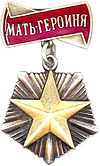






.png)

